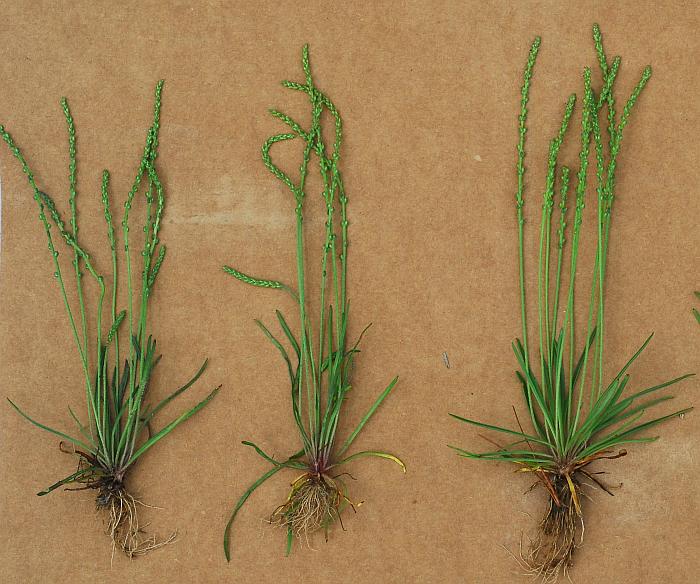Plantago elongata Pursh
Small Plantain

Native
CC = 1
CW = 3
MOC = 57
© SRTurner
Plantago elongata PurshSmall Plantain | |
 |
Native CC = 1 CW = 3 MOC = 57 |
© SRTurner |
|
Family - Plantaginaceae Habit - Taprooted or fibrous rooted perennial herb. Stems - Absent or very short. Leaves - In dense basal rosette, sessile, ascending to erect, to 6 cm long and 2.5 mm wide, linear to threadlike (those of seedlings sometimes broader), entire, glabrous or pubescent with short appressed hairs, green, with 1 main vein.
Inflorescences - 1 to several per plant, elongate terminal spikes to 7 cm long and 2-4 mm in diameter, loosely flowered with axis visible between flowers, the stalk to 8 cm long, strongly ascending to erect, solid, appressed-hairy.
Flowers - Bracts 1.0-2.5 mm long, shorter than to about as long as the flowers, lanceolate to ovate, with translucent margins and a thickened, green midnerve, angled to a bluntly or sharply pointed tip, glabrous. Cleistogamous flowers usually ubiquitous. Calyces deeply 4-lobed, 1.5-2.5 mm long, slightly zygomorphic, oblong-ovate to obovate, the keel glabrous, the relatively broad margins thin and papery. Corollas not noticeably zygomorphic, the lobes 0.5-1.0 mm long, lanceolate, sharply pointed at the tip, the margins entire, tan, all of the lobes erect and overlapping at flowering, appearing beaklike at fruiting. Stamens 2.
Fruits - 1-3 mm long, narrowly ellipsoid. Seeds mostly 4 per fruit, 1.0-1.8 mm long, the surface with a differentiated band on 1 side, otherwise finely pitted, tan to dark brown or black, shiny. Flowering - April - June. Habitat - Glades, savannas, upland prairies, bluff tops, forest openings, streambanks, roadsides, on acidic or sandy substrate. Origin - Native to the U.S. Lookalikes - Myosurus minima, grasses. Other info. - This little species almost defines "inconspicuous." It stands only a 3-4 inches high and the flowers are minute. Most people would consider it a weed, but it is a member of our native flora and does not exhibit a weedy growth habit. It is found through most of Missouri except for the far northern portion. In North America it is mainly found in three regions: the west coast, the upper Plains states and into Canada, and the lower Midwest. Photographs taken at Coldwater Conservation Area, Wayne County, MO, 4-15-2015 (SRTurner). |